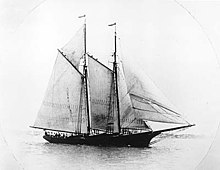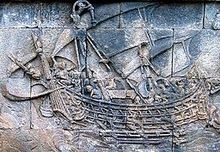Fore-and-aft rig



A fore-and-aft rig is a sailing vessel rigged mainly with sails set along the line of the keel, rather than perpendicular to it as on a square rigged vessel.[2]
Description
Fore-and-aft rigged sails include staysails, Bermuda rigged sails, gaff rigged sails, gaff sails, gunter rig, lateen sails, lug sails, tanja sails, the spanker sail on a square rig and crab claw sails.
Fore-and-aft rigs include:
- Rigs with one mast: the proa, the catboat, the sloop, the cutter
- Rigs with two masts: the ketch, the yawl
- Rigs with two or more masts: the schooner
Barques and barquentines are partially square rigged and partially fore-and-aft rigged.
A rig which combines both on a foremast is known as a hermaphroditic rig.
History
Austronesia

The fore-and-aft rig is believed to have been first developed independently by the Austronesian peoples some time around 1500 BC with the invention of the crab claw sail. It is suggested that it evolved from a more primitive "V"-shaped "square" sail with two spars that come together at the hull. Crab claw sails spread from Maritime Southeast Asia to Micronesia, Island Melanesia, Polynesia, and Madagascar via the Austronesian migrations.[3] Austronesians in Southeast Asia also later developed other types of fore-and-aft sails, such as the tanja sail (also known as the canted square sail, canted rectangular sail, or the balance lug sail).[3]
Their use later spread into the Indian Ocean since the first millennium, among vessels from the Middle East, South Asia, and China.[4][5]
The above developmental history of Austronesian sailing rigs is challenged by some working in the field. Atholl Anderson points out that there is little evidence of any of this maritime technology existing at the suggested points in prehistory. There is no archaeological or written evidence to support their early use – their existence has been argued on the basis that voyages of exploration and colonisation were made against the prevailing winds. This requires a rig that can sail to windward. Anderson (and others) argue that this "to windward" colonisation relies on occasional changes in the normal wind direction, often related to El Niño events. These were more common at the times in pre-history that coincide with phases of colonisation in new areas. Hence the early development of windward-sailing rigs is not a pre-requisite for the much of the Austronesian Expansion. Instead, using linguistic analysis of terms for elements of the more advanced Austronesian rigs, Anderson suggests that the primitive "mastless" rigs used by Austronesians were the only form until they encountered lateen technology in use by Arab sailing vessels of the 14th century. This is a complete reversal of the ideas of Campbell and others.[6]
Europe
The square rig had predominated in Europe since the dawn of sea travel, but in the generally gentle climate of southern Europe and the Mediterranean Sea during the last few centuries before the Renaissance the fore-and-aft began to replace it. By 1475, its use increased, and within a hundred years the fore-and-aft rig was in common use on rivers and in estuaries in Britain, northern France, and the Low Countries, though the square rig remained standard for the harsher conditions of the open North Sea as well as for trans-Atlantic sailing.
The triangular lateen sail was more maneuverable and speedier, while the square rig was labor-intense but seaworthy.
References
- ^ Casson, Lionel (1995): "Ships and Seamanship in the Ancient World", Johns Hopkins University Press, ISBN 978-0-8018-5130-8, pp. 243–245
- ^ Knight, Austin Melvin (1910). Modern seamanship. New York: D. Van Nostrand. pp. 507–532.
- ^ a b Campbell, I.C. (1995). "The Lateen Sail in World History". Journal of World History. 6 (1): 1–23. JSTOR 20078617.
- ^ Hobson, John M. The Eastern Origins of Western Civilisation. Cambridge University Press,2004, p. 58, ISBN 978-0-521-54724-6, ISBN 0-521-54724-5 "
- ^ Agius, Dionisius A. (2008). Classic Ships of Islam: From Mesopotamia to the Indian Ocean. BRILL. pp. 141, 160, 211–212, 382. ISBN 978-9004158634.
- ^ Anderson, Atholl (2018). "SEAFARING IN REMOTE OCEANIA Traditionalism and Beyond in Maritime Technology and Migration". In Cochrane, Ethan E; Hunt, Terry L. (eds.). The Oxford handbook of prehistoric Oceania. New York, NY. ISBN 978-0-19-992507-0.
{{cite book}}: CS1 maint: location missing publisher (link)
